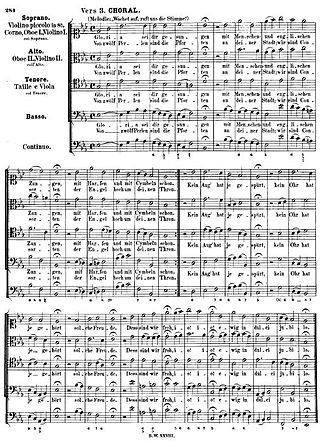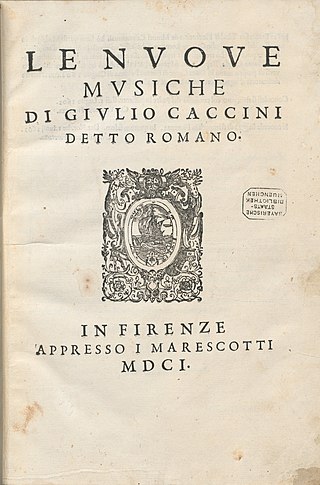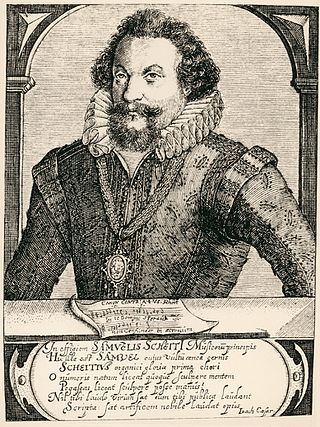
A Lutheran chorale is a musical setting of a Lutheran hymn, intended to be sung by a congregation in a German Protestant church service. The typical four-part setting of a chorale, in which the sopranos sing the melody along with three lower voices, is known as a chorale harmonization. The practice of singing in unison was the rule of the reformed churches, both in Germany and in other countries.
The trio sonata is a genre, typically consisting of several movements, with two melody instruments and basso continuo. It originated in the early 17th century and was a favorite chamber ensemble combination in the Baroque era.

In music, a solo is a piece or a section of a piece played or sung featuring a single performer, who may be performing completely alone or supported by an accompanying instrument such as a piano or organ, a continuo group, or the rest of a choir, orchestra, band, or other ensemble. Performing a solo is "to solo", and the performer is known as a soloist.

In music, monody refers to a solo vocal style distinguished by having a single melodic line and instrumental accompaniment. Although such music is found in various cultures throughout history, the term is specifically applied to Italian song of the early 17th century, particularly the period from about 1600 to 1640. The term is used both for the style and for individual songs. The term itself is a recent invention of scholars. No composer of the 17th century ever called a piece a monody. Compositions in monodic form might be called madrigals, motets, or even concertos.
Matthias Weckmann (Weckman) (c.1616 – 24 February 1674) was a German musician and composer of the Baroque period. He was born in Niederdorla (Thuringia) and died in Hamburg.

Samuel Scheidt was a German composer, organist and teacher of the early Baroque era.
Lodovico Grossi da Viadana was an Italian composer, teacher, and Franciscan friar of the Order of Friars Minor Observants. He was the first significant figure to make use of the newly developed technique of figured bass, one of the musical devices which was to define the end of the Renaissance and beginning of the Baroque eras in music.

Johann Hermann Schein was a German composer of the early Baroque era. He was Thomaskantor in Leipzig from 1615 to 1630. He was one of the first to import the early Italian stylistic innovations into German music, and was one of the most polished composers of the period.

Heinrich Scheidemann was a German organist and composer. He was the best-known composer for the organ in north Germany in the early to mid-17th century, and was an important forerunner of Dieterich Buxtehude and J.S. Bach.

Emilio de' Cavalieri, or Emilio dei Cavalieri, was an Italian composer, producer, organist, diplomat, choreographer and dancer at the end of the Renaissance era. His work, along with that of other composers active in Rome, Florence and Venice, was critical in defining the beginning of the musical Baroque era. A member of the Roman School of composers, he was an influential early composer of monody, and wrote what is usually considered to be the first oratorio.
A fantasia is a musical composition with roots in improvisation. The fantasia, like the impromptu, seldom follows the textbook rules of any strict musical form.
In music, a chorale concerto is a short sacred composition for one or more voices and instruments, principally from the very early German Baroque era. Most examples of the genre were composed between 1600 and 1650.
Franz Tunder was a German composer and organist of the early to middle Baroque era. He was an important link between the early German Baroque style which was based on Venetian models, and the later Baroque style which culminated in the music of J.S. Bach; in addition he was formative in the development of the chorale cantata.

Andreas Hammerschmidt was a German Bohemian composer and organist of the early to middle Baroque era. He was one of the most significant and popular composers of sacred music in Germany in the middle 17th century. He was nicknamed the "Orpheus of Zittau".
The year 1648 in music involved some significant events.
The first decade of the 16th century marked the creation of some significant compositions. These were to become some of the most famous compositions of the century.
The decade of the 1510s in music involved some significant events.

Baroque music refers to the period or dominant style of Western classical music composed from about 1600 to 1750. The Baroque style followed the Renaissance period, and was followed in turn by the Classical period after a short transition. The Baroque period is divided into three major phases: early, middle, and late. Overlapping in time, they are conventionally dated from 1580 to 1650, from 1630 to 1700, and from 1680 to 1750. Baroque music forms a major portion of the "classical music" canon, and is widely studied, performed, and listened to. The term "baroque" comes from the Portuguese word barroco, meaning "misshapen pearl". The works of Antonio Vivaldi, George Frideric Handel and Johann Sebastian Bach are considered the pinnacle of the Baroque period. Other key composers of the Baroque era include Claudio Monteverdi, Domenico Scarlatti, Alessandro Scarlatti, Alessandro Stradella, Tomaso Albinoni, Johann Pachelbel, Henry Purcell, Georg Philipp Telemann, Jean-Baptiste Lully, Jean-Philippe Rameau, Marc-Antoine Charpentier, Arcangelo Corelli, François Couperin, Johann Hermann Schein, Heinrich Schütz, Samuel Scheidt, Dieterich Buxtehude, Gaspar Sanz, José de Nebra, Antonio Soler, Carlos Seixas, Adam Jarzębski, Jan Dismas Zelenka, Heinrich Ignaz Franz Biber and Giovanni Battista Pergolesi.








